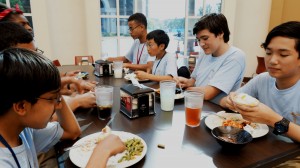
DALLAS (SMU) – Joy Brown-Bryant would like to be U.S. surgeon general one day. But first, the 14-year-old from Oakland, California, wants to help reconstruct the faces of military burn victims as a plastic surgeon. Brown-Bryant is well on her way to achieving her goal; she is spending the summer at Southern Methodist University taking college level science classes, extracting DNA from strawberry cells in biochemistry lab and preparing for weekly exams.
As one of 100 seventh- and eighth-grade minority STEMPREP Project students at SMU this summer, she is part of a program that boasts an impressive success rate – 100 percent of STEMPREP project students who finish the program attend college and 83 percent go on to graduate school to become physicians, pharmacists, dentists, researchers or engineers.
“Being in this program empowers students,” says Charles Knibb, STEMPREP director of academic affairs, an SMU research professor and a former surgeon.
The U.S. Department of Defense recently awarded the STEMPREP Project a $2.6 million grant to support its goal of increasing the number of minorities in STEM fields. According to a 2013 report from the U.S. Census Bureau, African Americans make up 11 percent of the U.S. workforce but only 6 percent of STEM workers. Hispanics make up 15 percent of the U.S. workforce, but just 7 percent of the STEM workforce.
Based at the Annette Caldwell Simmons School of Education and Human Development at SMU, the program recruits bright, science-minded middle school students for the first phase of the STEMPREP project. These students are currently living on campus for six weeks of college-level biology, chemistry, statistics and research writing classes, daily biochemistry labs, and the creation of a final in-depth research presentation on a disease. Each day begins with class at 9 a.m and wraps up after study hall at 9 p.m.
Moses Williams, executive director, founded the program in 1990 when he was admissions director for Temple University School of Medicine in Philadelphia.
“As a gatekeeper, I realized there were not a lot of minorities being considered,” he says. “I wanted to change that.” He compares the program to training young athletes: Identify talent early and then nurture it through practice and coaching.
In addition to science, students learn the nonacademic lessons of college life at SMU – sharing a room in a residence hall, selecting their own meals in the campus dining hall and washing their own clothes. “I’m an only child; I’ve always had my own room,” says Stephen Isabell, a seventh-grader from Olney, Maryland. “Living in a dorm is a lot different than home, but it’s worth it. I’m becoming more independent.”
One of the best parts? “Making new friends with people from all over the country,” says Brown-Bryant.
After two summers at SMU, students in grades 9 through 12 are ready to work as summer research interns at laboratories at universities, the National Institutes of Health and private industry, with careful mentoring all along the way. This summer, STEMPREP high school and college students are interning in research laboratories in Bethesda, Philadelphia, Vancouver and Dallas.
At SMU, 12 STEMPREP high school seniors have come full circle, returning to the university as counselors to the newest crop of young scientists.
“Being part of STEMPREP confirmed my decision to become a doctor,” says 18-year-old STEMPREP counselor Feaven Berhe. “In ninth grade when I started working in a research lab studying chemotherapy for breast cancer, I knew I wanted to pursue a medical career.”
Berhe assisted with breast cancer nanochemotherapy research for two summers at Thomas Jefferson University in Philadelphia and last summer conducted a behavioral study on rats at the National Institute on Drug Abuse. This summer she is assisting with pancreatic cancer research at the University of Texas Southwestern Medical School.
At 10 p.m. curfew each evening, Berhe checks on the seventh- and eighth-grade students in the residence hall. “It makes me emotional to talk with them,” she says. “They are beginning to realize that they are part of something that is life-changing.”




